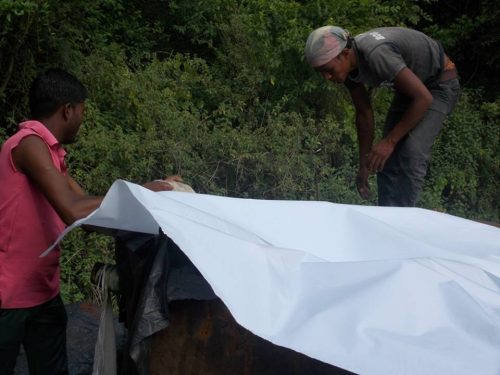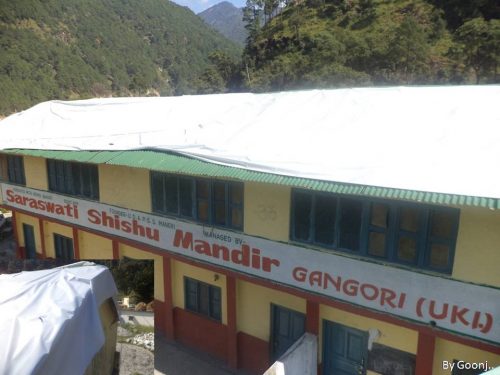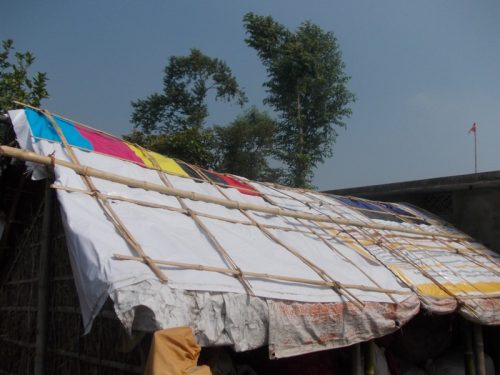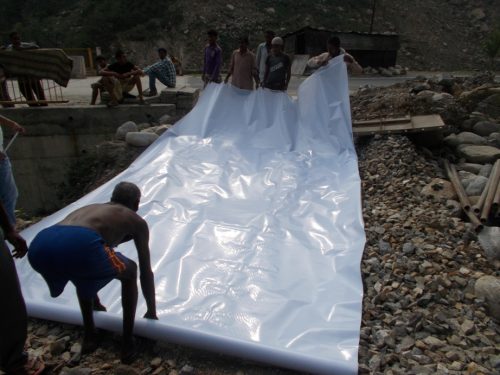TBI Blogs: How Discarded Material from Hoardings Is Helping Schools in Low-Income Areas, Flood Relief & More!
Banners and hoardings are often considered an urban nuisance. But this organisation's creative up-cycling of flex proves that every problem has a creative, eco-friendly solution.

Banners and hoardings are often considered an urban nuisance. But this organisation’s creative up-cycling of flex proves that every problem has a creative, eco-friendly solution.
We’ve all heard the famous dictum ‘When life gives you lemons, make lemonade.’ Simply put, it means that when life gives you a challenge, you can turn it into an opportunity. This story shines light on how innovative ideas can turn around the most complex of issues.
Banners are a common nuisance, a necessary evil and a part and parcel of our urban landscape. Most are made of what we commonly call flex (poly-vinyl chloride), a material similar to plastic. Its durability and cost effectiveness makes it the preferred material for display. Like plastic, flex too is harmful for the environment, since it is not biodegradable. However, adopting the flex for alternative uses will go a long way in reducing its harmful effect on the environment.
This story is about how we made the most of a potential problem and turned it into an opportunity, by creatively connecting the problem of flex with the challenges of the people we work with.

Back in 2013, a large roll of flex was used to cover the leaky roof of the school, Achrumal Saraswati Shishu Mandir School, situated in the interiors of Gangori in Uttarkashi. The flex lasted for an entire year, and saved the school from incessant worry about repairs and the impact of monsoons.
Flex pieces have also been sent to various villages in Uttron and Nald, in Uttarakhand on various occasions.
During the Uttarakhand floods, flex was used to cover the tin-roofs of shanties and on the floor of flood relief centres to prevent against moisture and cold.

In some centres, the flex continues to be used to ease the severe cold characteristic of the region and to make cleaning easier.
Soon, flex began to find its way into other products as well.
“I was discussing a product with the workshop supervisor. I needed to buy a lot of Bukram to ensure stiffness in our products. One day, I experimented with flex and used it instead of Bukram, as a base in making a men’s wallet. It worked beautifully,”says Reena, a Goonj member from Delhi.
“Gradually, we started using flex in many of our Green by Goonj recycled products. It’s definitely made our products more durable and strong.”

These flexes have also been very useful in protecting buildings from moisture, especially in areas where there is an absence of direct sunlight.
As a result, flexes have been sent to Bihar, Uttrakhand and Odisha as well. This in turn has helped in safeguarding material or stock stored in these buildings across the country.
After the 2008 Bihar floods, a lot of Vocational Training Centers were set up using local resources like bamboo, and by renovating abandoned structures under Goonj’s CFW initiative. Flex was used for roofing and covering the walls of these centers. Over the years, these centers have provided livelihood to many women in the neighboring 6 to 7 villages. The Vocational Training Center in Keshopur in the Medhepura district, has trained 750 girls and women so far; many of them have gone on to purchase sewing machines and set up their own businesses.
In schools where students were once forced to sit on tattered mats and daris, flex pieces have been cut into pieces and are being used as sitting mats.

At many Chehak Centers (informal tuition centers that complement formal government school education) started by Goonj, flex is taking the place of expensive tarpaulin, and the same funds are being used for other pressing needs. Two Chehak Centres (one in Saharsa and another in Purnea district of Bihar) are currently operational with over 200 children, with parents taking ownership of the center.
Flex pouches are also being distributed along with Goonj’s cloth sanitary pads called MY Pads.
These pouches are useful for women in far flung villages, who spend the entire day at work and do not have a place to store their used cloth pads for wash and reuse at a later stage.

Keeping in mind this practical difficulty, the little pouch is made from flex banners and used tarps. It is leak-proof, cheap and a sustainable way to ensure reuse of cloth pads.
So far, more than 13,000 such pouches have been made and distributed, along with MY Pads, in many states like Maharashtra, Uttarakhand, Bihar, Bengal and Madhya Pradesh, apart from many slums in Delhi and NCR.
This story is also about another dictum: ‘Let’s improve the world before we change it.’

From the roofs of makeshift shanties, to wallets and even pouches for sanitary napkins, finding alternative uses of flex is undoubtedly a step in the right direction to not only make full use of existing material, but to also save the environment while doing so.
Like this story? Or have something to share? Write to us: [email protected], or connect with us on Facebook and Twitter (@thebetterindia).
If you found our stories insightful, informative, or even just enjoyable, we invite you to consider making a voluntary payment to support the work we do at The Better India. Your contribution helps us continue producing quality content that educates, inspires, and drives positive change.
Choose one of the payment options below for your contribution-
By paying for the stories you value, you directly contribute to sustaining our efforts focused on making a difference in the world. Together, let’s ensure that impactful stories continue to be told and shared, enriching lives and communities alike.
Thank you for your support. Here are some frequently asked questions you might find helpful to know why you are contributing?


This story made me
-
97
-
121
-
89
-
167













